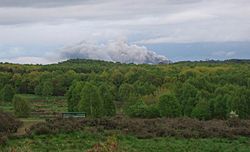Highgate Common facts for kids
| Highgate Common | |
|---|---|
 |
|
| Location | |
| Nearest Villages: | Swindon, Enville |
| County: | Staffordshire |
| Country: | England, United Kingdom |
| Information | |
| Area: | 320 acres [129 ha] |
| Status: | Common |
| Established: | 2004 |
| Designation: | Site of Special Scientific Interest |
| Administration | |
| Administrative authority: | South Staffordshire District Council |
Highgate Common is a special nature reserve in Staffordshire, England. It's a mix of open heathland and thick woodland. This large area, about 129 hectares (or 320 acres), is a popular spot for people to visit. It's also known as a Site of Special Scientific Interest, which means it's a really important place for wildlife and nature.
Contents
Where is Highgate Common?
Highgate Common is located in the southern part of Staffordshire. It sits on a high ridge overlooking the Smestow valley. If you're driving, it's close to villages like Swindon (1.2 miles away) and Enville (1.7 miles away). It's also about 10 miles from the city of Wolverhampton.
Who Looks After Highgate Common?
Since April 2009, Staffordshire Wildlife Trust has owned and managed Highgate Common. This trust is a charity that works to protect wildlife and wild places. Before them, the local council, South Staffordshire District Council, looked after the common.
There's usually a warden at Highgate Common most days. Wardens are like guardians of the park. They get help from other staff and volunteers to keep the common a great place for both people and animals.
Amazing Animals and Plants You Can Find
Highgate Common is home to one of the few remaining lowland heaths in Staffordshire. Lowland heaths are very special habitats. The common has many different types of plants, even though it's not a huge area.
Plants of the Heath and Woodland
The sandy heath areas are mostly covered with plants like:
These flowering plants are super important because they provide food and shelter for many small creatures. There are also areas of woodland with silver birch and oak trees. The ground in the woods is often covered with bracken ferns. You can also find areas with coniferous trees, like pines.
The common also has:
- Grassy areas
- Patches of bare sand and earth
- Small wet areas with two man-made ponds
This mix of habitats helps many different animals live here.
Incredible Insects and Other Creatures
Highgate Common has recorded 140 different types of animals. Many of these are rare, either in the whole country or just in this region. For example, there are 82 types of invertebrates (like insects), with 20 being rare in the region and 51 rare across the country.
Some of the most special insects include:
- Mining bees: At least four types of these bees are nationally rare. They dig burrows in the ground.
- Cuckoo bees: These bees, like Nomada and Sphecodes, are called "kleptoparasitic." This means they lay their eggs in the burrows of other bees, letting the host bee raise their young.
- Solitary wasps: These wasps live alone, not in a colony. Some are even wingless!
- Small red-tailed bumble bees: These are regionally important.
You can also spot other animals like:
- Common lizards
- Slowworms (which are legless lizards, not snakes!)
- Grass snakes
- Rabbits
- Bush-crickets
- Many kinds of moths, beetles, flies, and dragonflies
How the Land Was Formed
Highgate Common sits on top of a type of rock called Mid-Severn Sandstone. This sandstone was formed millions of years ago during the Permian and Triassic periods. You can see similar sandstone formations at places like Kinver Edge and Cannock Chase.
The common itself is like a shallow bowl on a flat area. This shape, along with the plants, creates a slightly warmer climate than other parts of England. This warmer "micro-climate" helps the local plants and animals thrive.
A History of the Landscape
The thin, sandy soil here used to support open woodlands with birch, oak, and beech trees. Long ago, people used these woods to graze pigs. This is why some local place names, like Swindon, refer to pigs.
After the Norman Conquest, this area became part of a huge forest called Kinver Forest. But over time, especially from the 1500s, much of the forest was cut down. This turned the area into the sandy heathland we see today. It's a landscape shaped by humans, but it's now very important for wildlife.
During World War II, parts of the common were used for farming. Concrete roads and channels were even built. However, with careful management, including thinning out trees, the diverse habitat has been brought back. Today, it's mostly heathland with lots of heather, along with open woodland, small ponds, and bogs. The land is often hilly and rough, making it an interesting place to explore.
Things to Do at Highgate Common
Highgate Common is a popular place for people who love to walk, especially dog walkers. There are several car parks where you can leave your car.
You'll find many footpaths, some of which are marked with signs. Some paths are even designed for wheelchairs, making them accessible for everyone. There are also paths for horse riding. You can find seats and picnic tables in many spots around the common.
Part of the long-distance walking route called the Staffordshire Way goes through Highgate Common. This path connects the common to many other interesting places in Staffordshire and nearby counties.
In February 2010, a new Warden's office opened. It has toilets, a meeting room, information points, and more picnic facilities. There's also an extra car park there.


